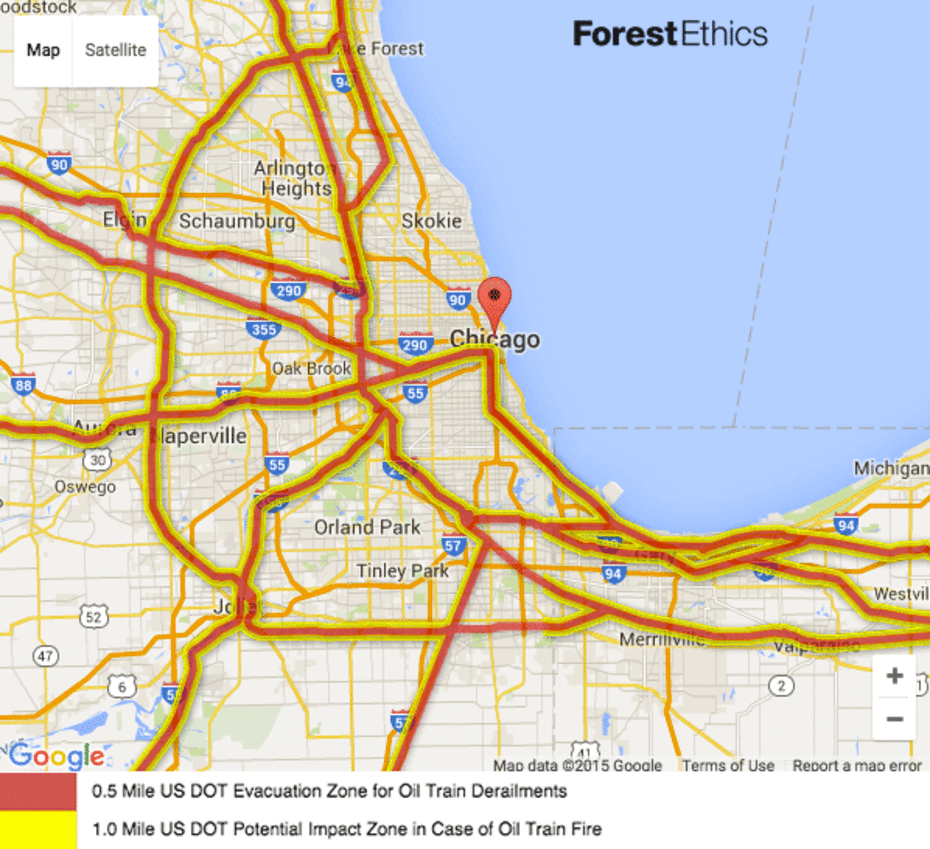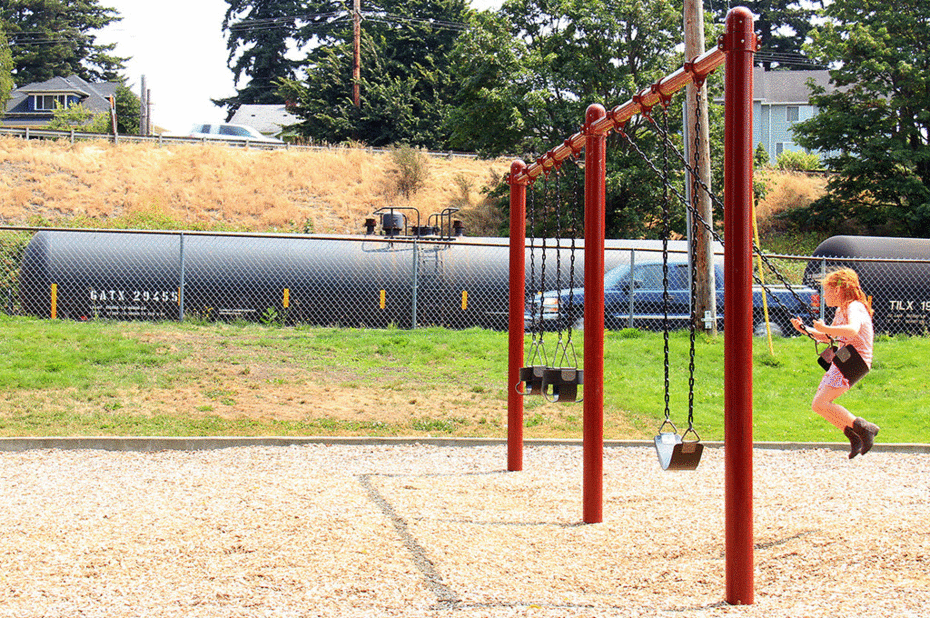On any given school day, some 350 children wave goodbye to their parents and pile into the Jungman Elementary School in southwest Chicago. While the students are supposed to be learning their multiplication tables, they may gaze out their classroom windows, staring at the trains chugging down the tracks just a block or so away. This scenario wouldn’t be too worrying except for the fact that many of those trains are carrying upwards of a million gallons of highly flammable crude. And of late, oil trains haven’t had the best safety record.
A national record of 1.4 million gallons of oil spilled in 2013 in mishaps that included major derailments in Alabama and North Dakota. According to the Pipeline and Hazardous Materials Safety Administration, 2014 saw the number of “unintentional releases”—due, in part, to trains jumping the track—hit an all-time high of 144. In the Midwest, two trains derailed in Wisconsin last month, and, last March, another derailed and caught fire near Galena, Illinois, spilling 200,000 gallons of oil.
The environmental non-profit ForestEthics created a “blast zone” map last year that shows the areas of the country most vulnerable to oil train accidents. The group followed up this fall with a blast-area map factoring in data from the Department of Education. The report found that Chicago, with 77,000 kids at schools in that zone, is one of the top five cities in the United States in terms of schoolchildren at risk from oil train derailments and explosions. (The others are Houston, Philadelphia, Los Angeles, and El Paso.) Nationwide, as many as 5.7 million kids attend a school within one mile of railroad tracks that carry oil cars, a proximity that puts their schools in what the Department of Transportation considers a “potential impact zone.”

Despite the small dip in oil transportation last year that coincided with plummeting prices, the amount of crude on the nation’s railways is 4,000 percent higher than it was six years ago. An analysis by the Association of American Railroads showed that, in 2013, trains transported roughly 300 million barrels of crude nationwide. Seventy percent of that oil originates in North Dakota’s Bakken region. Much of the rest comes down from Canada’s tar sands.
Many of these oil trains pass through Chicago, where six of the seven largest railroads in the country converge. As in the other cities, the trains travel smack through downtown areas. With the government predicting an average of 10 fuel train derailments per year over the next two decades, that’s cause for concern, says Eddie Scher, communications director for ForestEthics.
The federal government regulates railroads, so, following the Galena accident last spring, mayors from nearby towns called on the feds to improve oil tank car safety. Regulations subsequently issued in May require the oldest cars in use to be phased out over the next decade. But many groups, including ForestEthics and the Natural Resources Defense Council, argue that’s not soon enough.
“There’s a fundamental problem, which is that you can’t put 30,000 gallons of crude oil in a train car,” Scher says. The oil emits gases that build up in the railcars as the trains rumble across the country. And those railcars are not meant to hold that kind of pressure, Scher says.
Local municipalities have little power to prevent disaster—or to change when or where trains go. The best they can do is ready first responders, something the Illinois Emergency Management Agency has been doing for years.

Illinois schools are required by the state’s School Safety Drill Act to prepare for the possibility of hazardous-material spills. There’s nothing special the schools have to do specifically in the case of an oil spill or, say, a fiery derailment. (No one from the Chicago Public Schools responded to calls requesting comment.) That rail companies are known for their secrecy adds to the uncertainty of how safe some of these schools may be in the case of a train disaster.
Rail companies aren’t required to publicly disclose when or where their oil trains travel; they say releasing that information poses a security risk. A bill currently in Congress would, at the very least, force these companies to create government-approved oil spill response plans, but that same bill could also exempt them from disclosing those plans to the public, including school districts.
According to a 2014 federal emergency mandate, what rail companies do have to share is how many of their trains carry a million gallons of oil or more (about 35 cars). Many give broad estimates, though—at least one company told IEMA that it sends anywhere from 10 to 35 million-gallon trains through Illinois each year—and they don’t have to provide an update unless there’s a 25 percent increase or decrease in traffic.
Still, it’s an improvement, says IEMA Spokeswoman Patti Thompson. “We really had no information whatsoever as to the frequency or the routes they were taking,” she says. “We’ve really gone from nothing to a fair amount of information with this.”
The emergency mandate also opened everyone’s eyes to the sheer amount of oil moving along the tracks and forced the agency to shift its focus, Thompson says. IEMA now has firefighters train specifically for Bakken crude spills—a prudent move, since those outdated train cars keep rolling on, past Jungman Elementary School—and tens of thousands of other little scholars.

This story originally appeared on Earthwire as “Stop, Drop, and Roll” and is re-published here under a Creative Commons license.




